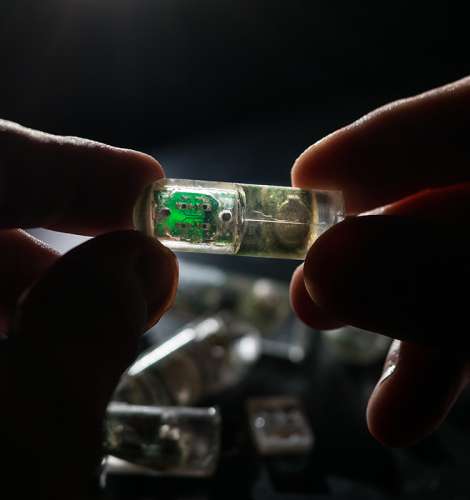Few devices are currently available to probe hard-to-access areas of the gut to provide measurements under true physiological health or disease conditions.
In a trial demonstration in pigs, a newly created edible electronic device has now shown to be effective in detecting molecules indicative of excess bleeding in the gut.
The innovative device
The device the researchers called Ingestible Micro-Bio-Electronic Device, IMBED, features bacterial cells designed and programmed to sense specific biochemical associated with health or disease.
These bacteria are then placed in a pill with semipermeable membrane. When the target gut chemical diffuse across this membrane, it activates the bacteria, causing them to light up, enabling a wireless signal to be sent to a terminal (computer or cell phone).
The sensor, which is a cylinder about 1.5 inches long, requires about 13 microwatts of power. The researchers equipped the sensor with a 2.7-volt battery, which they estimate could power the device for about 1.5 months of continuous use (see picture and caption for more).
Implications
The technology, now at the prototype stage, could one day be used to detect the presence of different disease-associated biochemical molecules in the gut, and relay the resulting measurements to a cell phone in real time.
To help move the technology forward, the researchers plan to reduce the size of the sensor and to study how long the bacteria pills can survive in the digestive tract. They also hope to develop sensors for gastrointestinal conditions other than bleeding.
The researchers also reported that they have adapted the described sensors for two other molecules, which they have not yet tested in animals. One detects a sulfur-containing ion called thiosulfate, which is linked to inflammation and could be used to monitor patients with Crohn's disease or other inflammatory conditions. The other detects a bacterial signalling molecule called AHL, which can serve as a marker for gastrointestinal infections.
The researchers are from the Massachusetts, USA, including Massachusetts Institute of Technology (MIT) in Cambridge, Koch Institute for Integrative Cancer Research in Cambridge, MassGeneral Hospital for Children in Boston, Harvard Medical School in Boston, and Women's Hospital in Boston. Their findings are reported in the journal Science.
How does the device work in the experiment?
By injecting and introducing a gene that triggers in the presence of the blood chemical heme, and another to make the cell glow when triggered, scientists were able to genetically programmed bacterium commonly sold as a probiotic in Europe to detect blood heme.
They then packaged 44 million bacteria, a battery, a light detector, and other electronics into 10-millimeter-by-30-millimeter ingestible pills. The sensor can send a wireless signal to an electronic circuit when it detects glowing light from the bacteria.
In this proof of concept experiment, the scientists fed three pigs with the pills. Only the pig with bleeding in the gut triggered the sensor, replaying information about the condition to a cell phone.
The scientists suggest that the sensor can be modified to detect other biochemical molecules besides heme.





